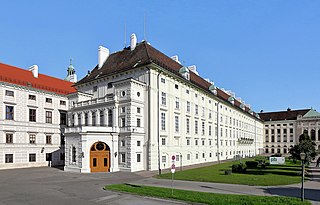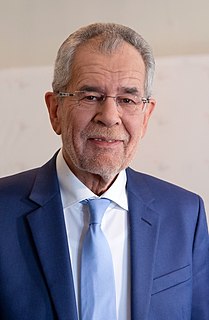 W
WThe Government of Austria is the executive cabinet of the Republic of Austria. It is composed of the Chancellor, who is head of government, the Vice-Chancellor, and the ministers.
 W
WAn Austrian passport is issued to citizens of Austria to facilitate international travel. Every Austrian citizen is also a citizen of the European Union. The passport, along with the national identity card allows for free rights of movement and residence in any of the states of the European Economic Area and Switzerland.
 W
WThe Federal Chancellor of Austria is the head of government of the Republic of Austria. The position corresponds to that of Prime Minister in several other parliamentary democracies. The term is gendered in the German language.
 W
WThe Constituent National Assembly, elected on 16 February 1919, was the first parliament in Austria's history to be elected by women and men in free and equal elections. On 4 March 1919 it replaced the Provisional National Assembly based on the 1911 Imperial Council elections. The National Assembly adopted the Habsburg Act, ratified the Treaty of Saint-Germain, which sealed the collapse of Cisleithania and demanded Austria's independence from Germany. In its last meeting on 1 October 1920, the assembly created the until-now lasting Constitution of Austria. It was the first time that women in Austria had suffrage in national elections.
 W
WThe Director General for the Public Security, also known as Security Director, is the head of the Directorate General for the Public Security and as such exercises direct operational control over the vast majority of federal law enforcement agencies in Austria. The Director General is the highest-ranking police officer of the country and an official within the Ministry of the Interior.
 W
WIn Austrian politics, the Chancellery is the ministry led by the chancellor. Since the establishment of the First Austrian Republic in 1918, the Chancellery building has also been serving as the venue for the sessions of the Austrian cabinet. It is located on the Ballhausplatz in the centre of Vienna, vis-à-vis the Hofburg Imperial Palace. Like Downing Street, Quai d'Orsay or – formerly – Wilhelmstrasse, the address has become a synecdoche for governmental power.
 W
WIn Austrian politics, the Federal Ministry for Arts, Culture, the Civil Service and Sport is the ministry in charge of arts, culture, public employment law, civil service job training, civil service staff representation, administration management in general, and sport.
 W
WIn Austrian politics, the Federal Ministry for Climate Action, Environment, Energy, Mobility, Innovation and Technology is the ministry in charge of railways, transport policy, environment and the energy sector.
 W
WIn Austrian politics, the Federal Ministry for Digital and Economic Affairs is the ministry in charge of promoting commerce and industry, overseeing public works, and maintaining the public infrastructure. In some recent cabinets, it has also been responsible for employment; in others, for family affairs and science.
 W
WIn Austrian politics, the Federal Ministry of Agriculture, Regions and Tourism is the ministry in charge of agricultural policy, forestry, hunting, fishing, viticulture and wine law, postal and telecommunications services, mining, animal welfare, and the tourism industry. The Ministry was first created in 2000 through a merger of the Ministry of Agriculture (Landwirtschaftsministerium) and the Ministry of Environment (Umweltministerium); it gained responsibility for the energy sector, mining, and tourism under the first Kurz cabinet in 2018.
 W
WIn Austrian politics, the Federal Ministry of Social Affairs, Health, Care and Consumer Protection is the ministry in charge of welfare policy.
 W
WThe Federal Monuments Office is a department of the Federal Chancellery responsible for cultural heritage in Austria.
 W
WThe General Secretary of the Interior is the chief of operations and second-highest ranking officer of the Ministry of the Interior of Austria. The General Secretary supervises and manages the ministry's day-to-day operations and directly oversees the heads of the ministerial sub-departments.
 W
WIn Austrian constitutional law, a minister is a member of the national cabinet. Most ministers are responsible for a specific area of Austrian public administration and stand at the head of a specific department of the Austrian bureaucracy; ministers without portfolio exist and used to be common in the First Austrian Republic but are rare today. Most ministers control a ministry; some ministers control a section of the Chancellery, the ministry headed by the chancellor. A minister is the supreme executive organ within his or her area of responsibility: ministers do not take orders from either the president or the chancellor; their decisions are subject to judicial review but cannot be overruled by any other part of the executive branch.
 W
WThe president of Austria is the head of state of the Austrian Republic. Though theoretically entrusted with great power by the Constitution, in practice the president is largely a ceremonial and symbolic figurehead.
 W
WThe President of the Constituent National Assembly was the head of state of the Republic of German-Austria and later the First Austrian Republic, as well as the presiding officer of the Constituent National Assembly. The office was only held by Karl Seitz.
 W
WThe President of the National Council is the presiding officer of the National Council, the lower house of the Austrian Parliament.
 W
WThe Presidential Chancellery of Austria is an institution that assists the President with fulfilling his tasks as head of state. It is headquartered in the Leopoldine Wing of the Hofburg. The Chancellery is divided into several groups: group European and international affairs, protocol and organisation, group legal, social and administrative affairs and the group domestic affairs and adjutant's office of the President.
 W
WThe Provisional National Assembly, unofficially also referred to as the Vienna National Assembly, was the first parliament of the Republic of German-Austria. It functioned during and after the collapse of the Austro-Hungarian Empire from 21 October 1918 to 16 February 1919. The last meeting took place on 6 February 1919 when the Geschäftsordnung for the Constituent Assembly was adopted. The assembly was composed of the members of the Chamber of Deputies of the former Imperial Council, who had represented the German-speaking areas of the Austrian half of the dual monarchy. It therefore also involved delegates whose territories were not allowed to join German-Austria because of the Treaty of St. Germain. The 208 deputies were all men; in the elections of 1911 women had not been eligible to vote yet.
 W
WThe State Council was the executive leadership of the Republic of German-Austria, a collegiate body established in the last days of World War I by the Provisional National Assembly.
 W
WIn Austrian constitutional law, a supreme executive organ , is an elected official, political appointee, or collegiate body with ultimate responsibility for a certain class of administrative decisions – either decisions in some specific area of public administration or decisions of some specific type. The president, for example, is the supreme executive organ with regards to appointing judges; the minister of justice is the supreme executive organ with regards to running the prosecution service; the president of the Constitutional Court is the supreme executive organ with regards to the operational management of the Constitutional Court. The Constitutional Court itself, on the other hand, is not a supreme organ because its decisions, while definitive, are judicial and not administrative in nature.